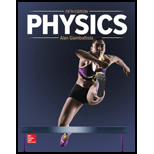
Concept explainers
(a)
The wavelengths can absorbed by the
(a)
Answer to Problem 64P
The wavelengths can absorbed by the
Explanation of Solution
Write the expression for the absorbed energy associated from the transition between the energy levels.
Here,
Write the expression for the
Here,
Write the expression for wavelength.
Here,
Use equation (II) and (I) in (III) to solve for absorbed wavelength associated from the transition between the energy levels.
Conclusion:
Substitute
Substitute
Substitute
Substitute
Therefore, the wavelengths can absorbed by the
(b)
The recoil speed of the atom after absorption.
(b)
Answer to Problem 64P
The recoil speed of the atom after absorption are
Explanation of Solution
Write the expression for the energy of the photon.
Here,
Write the expression for
Write the expression for the momentum associated with the photon.
Use equation (V) and (VI) in (VII) to solve for
Write the expression for momentum associated with hydrogen atom.
Here,
Equate equation (IX) and (VII) to solve for recoil velocity.
Conclusion:
Substitute
Substitute
Therefore, the recoil speed of the atom after absorption are
(c)
The wavelength of each photon emitted and classify its region in
(c)
Answer to Problem 64P
The wavelength of photon emitted from
Explanation of Solution
Use equation (IV) to solve for the wavelength associated with the absorbed wavelength associated from the transition between the energy levels.
Conclusion:
Substitute
Substitute
Substitute
Substitute
Substitute
Substitute
Therefore, the wavelength of photon emitted from
Want to see more full solutions like this?
Chapter 27 Solutions
Physics
- A hydrogen atom is excited from its ground state to the state with n= 4. (a) How much energy must be absorbed by the atom? Consider the photon energies that can be emitted by the atom as it de-excites to the ground state in the several possible ways. (b) How many different energies are possible; what are the (c) highest, (d) second highest, (e) third highest, (f) lowest, (g) second lowest, and (h) third lowest energies?arrow_forwardWhat are the (a) energy, (b) magnitude of the momentum, and (c) wavelength of the photon emitted when a hydrogen atom undergoes a transition from a state with n = 3 to a state with n = 1?arrow_forwardAn argon laser emits a beam of light of wavelength 4.88 × 10-7 m, the power in the beam being 100mW. How many photons per second are emitted by the laser? If the beam falls on the cesium cathode of a photocell, what photoelectric current would be observed, assuming 10% of the photons are able to eject an electron?Given that the limiting frequency v0 of cesium is 5.2 × 1014Hz, what reverse potential difference between the cell electrodes is needed to suppress the photocell current?arrow_forward
- If a photon of wavelength 0.0665 nm hits a free electron and is scattered at an angle of 35◦ from its original direction, findat. the change in wavelength of this photon,b. the wavelength of the scattered photon,vs. the change in energy of the photon (is it a loss or a gain?), and d. the energy gained by the electron.arrow_forwardThrough what angle must a 200 keV photon be scattered by a free electron so that the photon loses 10% of its energy?arrow_forwardFind the shortest wavelength of a photon that can be emitted by a hydrogen atom, for which the initial state is n = 12.arrow_forward
- If the work function of a metal is 3.2 eV, what is the maximum wavelength that a photon can have to eject a photoelectron from this metal surface?arrow_forwardDerive an expression for the ratio of X-ray photon frequency for two elements with atomic numbers Z1 and Z2.arrow_forwardWhen a hydrogen atom is in its third excided state, what are the shortest and longest wavelengths of the photons it can emit?arrow_forward
- Why is the following situation impossible? An experiment is performed on an atom. Measurements of the atom when it is in a particular excited state show five possible values of the z component of orbital angular momentum, ranging between 3.16 x 10-34 kg ⋅ m2/s and -3.16 x 10-34 kg ⋅ m2/s.arrow_forwardCan an electron in a hydrogen atom have a speed of 3.60 × 105 m/s? If so, what are its energy and the radius of its orbit? What about a speed of 3.65 × 105 m/s?arrow_forward
 Modern PhysicsPhysicsISBN:9781111794378Author:Raymond A. Serway, Clement J. Moses, Curt A. MoyerPublisher:Cengage Learning
Modern PhysicsPhysicsISBN:9781111794378Author:Raymond A. Serway, Clement J. Moses, Curt A. MoyerPublisher:Cengage Learning Principles of Physics: A Calculus-Based TextPhysicsISBN:9781133104261Author:Raymond A. Serway, John W. JewettPublisher:Cengage Learning
Principles of Physics: A Calculus-Based TextPhysicsISBN:9781133104261Author:Raymond A. Serway, John W. JewettPublisher:Cengage Learning University Physics Volume 3PhysicsISBN:9781938168185Author:William Moebs, Jeff SannyPublisher:OpenStax
University Physics Volume 3PhysicsISBN:9781938168185Author:William Moebs, Jeff SannyPublisher:OpenStax Glencoe Physics: Principles and Problems, Student...PhysicsISBN:9780078807213Author:Paul W. ZitzewitzPublisher:Glencoe/McGraw-Hill
Glencoe Physics: Principles and Problems, Student...PhysicsISBN:9780078807213Author:Paul W. ZitzewitzPublisher:Glencoe/McGraw-Hill



